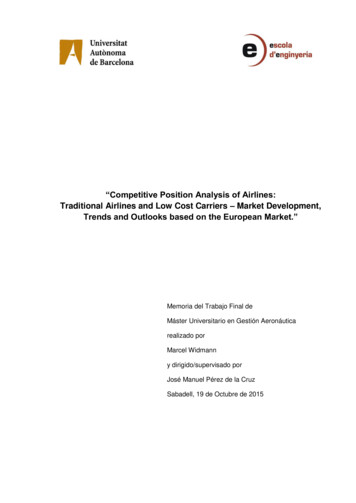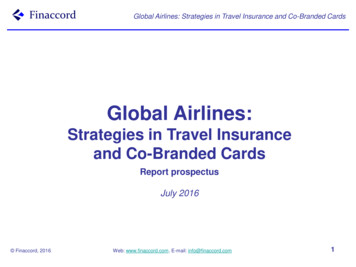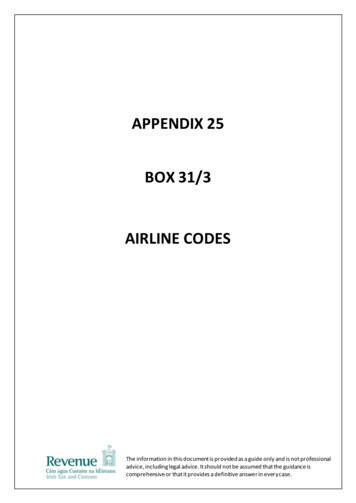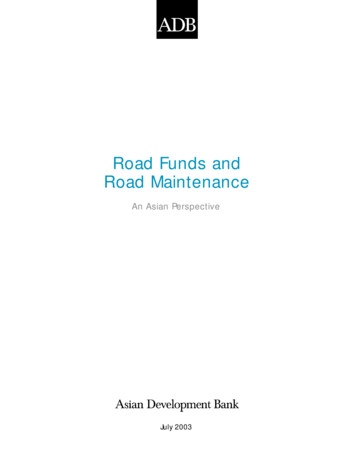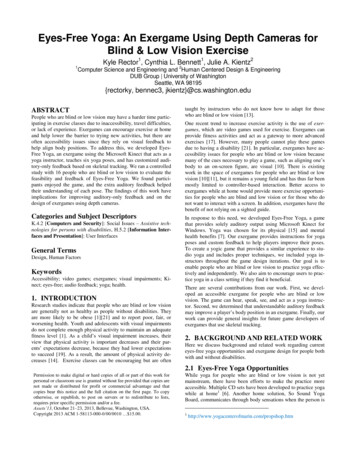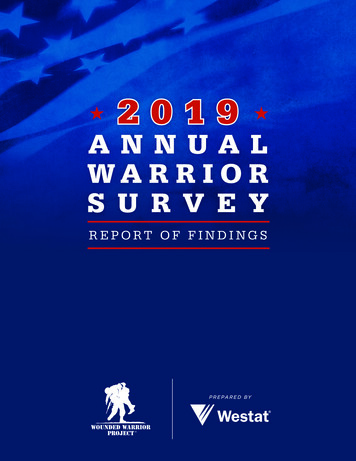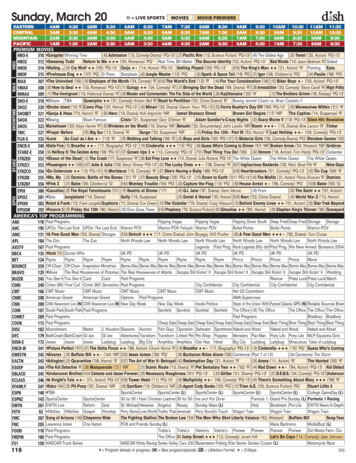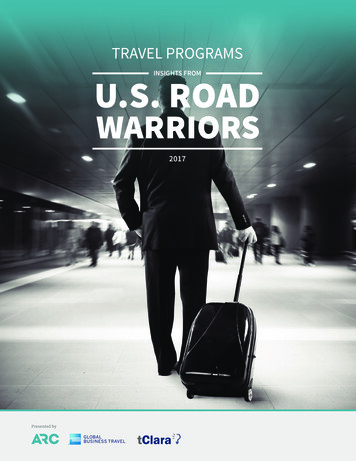
Transcription
TRAVEL PROGRAMSINSIGHTS FROMU.S. ROADWARRIORS2017Presented by 2017 Airlines Reporting Corporation (ARC), American Express Global Business Travel and tClara.
The Hidden Expenses of a Cost-Focused Travel ProgramExamining the high cost of tough travel policies, and what companies gain by improving trip qualityfor their road warriorsBusiness travel is an important investment. Companies spend millions of dollars to empower road warriors to do what they do best:Meet new people, forge connections and facilitate positive business outcomes, ultimately delivering a return on the company’sinvestment in travel.But for those who manage business travel, balancing cost with traveler success can be a challenge. Corporate travel managers areconsistently under pressure to cut the costs of their travel programs. As a result, travel managers tighten travel policies where possible, often opting for less-expensive hotels and less-convenient flights in order to keep their road warriors traveling.However, tougher, cost-focused travel policies carry significant negative consequences, according to a recent survey of more than750 business travelers, sponsored by Airlines Reporting Corporation (ARC), American Express Global Business Travel and tClara. 1The survey results highlighted several notable distinctions between business travelers in “cost-focused” programs—travel programsthat prioritize low travel costs—and those in “traveler-focused” programs, which place emphasis on the business traveler’sproductivity and satisfaction.Survey results show that road warriors in cost-focused programs have 22 percent fewer effective trips than their colleagues intraveler-focused programs, and they are twice as likely to experience symptoms of traveler friction—the wear and tear of too muchtravel.“Tough, tight travel policies have significant business costs,” said Scott Gillespie, managing partner at tClara. “You’ll save money inthe travel budget, but you’re buying less-effective trips and causing more frustrated travelers.”For corporate travel managers seeking to design an optimal travel program, travel and expense (T&E) costs are only part of theequation. Gillespie asserts that the total costs of traveler friction, including attrition, health, productivity and trip outcomes, are alsosubstantial—and measurable—factors to consider.Survey results show that road warriors in cost-focused programs have 22 percentfewer effective trips than their colleagues in traveler-focused programs.The Measurable Costs of Cheaper TravelThe success of a travel program is often tied to cost savings, leaving travel managers with no easy way to balance tangible T&E costswith the intangible costs of traveler friction.The study assessed some of the most common symptoms of traveler friction. Top symptoms include reduced quality of sleep,difficulty maintaining a healthy lifestyle, stress, and worry about the impact of work travel on personal life. Travelers in costfocused travel programs reported twice as much traveler friction as their colleagues in traveler-focused programs. Of these highfriction travelers, 74 percent say they hope to travel much less in the future. 2017 Airlines Reporting Corporation (ARC), American Express Global Business Travel and tClara.2
Traveler FrictionSymptoms for RoadWarriorsTravelers in cost-focusedprograms reported, on average,twice as much traveler frictionas their colleagues in travelerfocused programs.TRAVELER FRICTIONSYMPTOMSCOSTFOCUSEDTRAVELERFOCUSEDI sleep much better at home than when traveling82%53%I find it hard to have a healthy lifestyle whentraveling74%32%I worry about the impact of traveling for work onmy personal life72%34%The wear and tear of business travel oftencauses me to be less effective during or rightafter my trips71%33%I often have little advance notice before my trips70%38%I often feel extra stress in the days before a trip72%30%I find it hard to keep up with my workload whiletraveling68%26%I occasionally get sick or need time off workbecause I travel so much67%29%I get afraid during some of my trips58%26%Two years from now, I hope to be traveling muchless74%35%Travelers in cost-focused travelprograms reported twice as muchtraveler friction as their colleaguesin traveler-focused programs.It’s clear that traveler friction has a negative impact onemployees themselves, as well as their productivity on behalf ofthe company. When road warriors were asked what percentageof their trips, in hindsight, were worthwhile, those in travelerfocused programs reported an average of 82 percent. Thosein cost-focused programs, however, reported 22 percent fewereffective trips—they rated only 60 percent as worthwhile.Assigning an exact cost to traveler friction is difficult, but abusiness’s road warrior attrition rate can help corporate travelmanagers quantify the impacts of travel program policies ontalent retention. Attrition rate can also become a powerful toolin communicating priorities with senior management.According to a report by the Center for American Progress,replacing a highly paid employee requiring specialized trainingcan cost up to 213 percent of the employee’s annual salary.Additional indirect costs can include reduced team morale,decreased productivity, and the loss of clients and institutionalknowledge. 2 2017 Airlines Reporting Corporation (ARC), American Express Global Business Travel and tClara.3
Designing a traveler-focused travel program can helpcompanies retain top talent, especially in sales, accountmanagement and technical positions with valuablerelationships and specialized areas of knowledge. As an addedbenefit, it also makes the company far more attractive topotential employees.According to a report by the Center forAmerican Progress, replacing a highlypaid employee requiring specializedtraining can cost up to 213 percent ofthe employee’s annual salary.Of those business travelers surveyed, 84 percent said theywould be interested in a job from a different firm that requiressimilar travel levels if it offers a very attractive travel policy,and 83 percent said the new firm’s travel policy would be atleast equally important to, if not more important than, the newpay and responsibilities.What Road Warriors Really WantIt’s clear that road warriors are valuable employees whosacrifice a lot of personal time and comfort to serve thecompany, but exactly how much do they give up when theytravel for business? In addition to the aforementioned travelerfriction symptoms, business travelers sacrifice a morequantifiable resource in order to travel—their personal time.“The top 10 percent of travelers out there, your road warriors,are spending nearly four weeks of their personal time on aplane,” said Gillespie, referencing flights before 8 a.m. or after 6p.m. Monday – Friday, or any time Saturday and Sunday. Thesetravelers also spend an average of 88 nights away from homeand book nearly 90 percent of flight hours in economy class.Nights away fromhomeon worktripsin warrior] is saying, ‘I’m soGillespiecontinued,“[Theroadthe past12 monthscommittedto yourbusiness, that I’m going to give [my fourweeks of vacation] back to you, flight by flight.’ That’s a majorMore than one-third of roadcommitment.”warriors spent 35 to 50 nightsaway from home during theSo whatemployeesreallywant from their travel programs?pastdo12 months,whileanotherone-thirdspent51 to 85businessnights travelers in cost-focusedAccordingto thesurvey,away fromon businessprogramsmosthomecommonlyrequest non-stop flights whenduring the past 12 months.available; the ability to fly premium economy on domesticOnly 13 percent of road warflights;flyingbusinessclassriorstraveledmore than121on flights longer than sixhours;easiernightson expensebusiness. reporting; and reimbursement andpolicies, they have a very different set of asks. Their travelpolicies are already designed to improve productivity.” Toprequests for those in traveler-focused programs include paidtime off after a long trip; the flexibility to work from home theday before or the day after a trip; and occasional two-weekperiods of work with no travel, spaced throughout the year.“These folks want to recharge,” he said.Quantifying Trip QualityIn traveler-focused programs, emphasizing the traveler’sproductivity and satisfaction generally results in higher T&Eprices, as well as higher trip quality. To measure trip quality,Gillespie draws from two key metrics to create an objective“trip quality score,” a blended score that takes into account thequality of business travelers’ flights and hotels.The first metric, flight quality, is based on the cabin and numberof stops. The second component is a hotel quality rating, whichcan be determined by the hotel brand (or sub-brand). Luxuryclass brands would receive a much higher score than economyoriented hotel brands.Gillespie calls for blending the flight quality score with thehotel quality rating to create an overall trip quality score.“Trip quality is the key indicator of a traveler-focused travelprogram,” said Gillespie. “As trip quality increases, so dotraveler safety and price. But road warrior attrition and tripscrap rate, on the other hand, should decline. I believe the dataclearly shows that higher-quality trips provide more value andproductivity to the company.”Decisions That Make an ImpactTravel programs don’t change overnight, but managers ofthese programs can start making small, conscious decisionsthat shift their policies from a cost-focused model to a moretraveler-focused model.Gillespie recommends starting with some of the mostfrequently requested trip factors. Some of these factors arerelatively inexpensive to the company: paid time off after a trip,the ability to work from home the day before or after a trip, andmore efficient expense reporting/reimbursement. But the mosthighly ranked factors among road warriors in cost-focusedprograms—non-stop flights, higher-quality flights and hotels,and reimbursement for lounge membership, TSA PreCheck orGlobal Entry—should deliver increased productivity and lowertrip scrap rates.reimbursement for airline lounge membership, TSA PreCheckor Global Entry.“Basically, they want more productivity,” said Gillespie.“When you ask travelers that are under traveler-friendly 2016 Airlines Reporting Corporation (ARC), American Express Global Business Travel and tClara.“I believe the data clearly shows thathigher-quality trips provide more valueand productivity to the company.”- Scott Gillespie4
Most Important Factors to Make Travel Easier/BetterWhen asked to rank 24 potential improvements in order of importance, no single option garnered more than 20 percent. However, thetop-ranked improvements varied between those in cost-focused and traveler-focused programs.Top Requests for Travelers in a Cost-Focused Program1. Taking non-stop flights whenever they are available (20%)2. Flying premium economy on domestic flights (16%)3. Flying business class on flights longer than six hours(14%)4. Easier expense reporting (11%)5. Reimbursement for airline lounge membership, TSA PreCheck, Global Entry, etc. (11%)6. Ability to choose more comfortable and/or convenienthotels (11%)7. Ability to book with a really good travel agent (11%)8. Paid time off after a long trip or after a long period offrequent trips (11%)9. Less need for using my personal funds, or quickerexpense reimbursements (11%)Top Requests for Travelers in a Traveler-Focused Program1. Paid time off after a long trip or after a long period offrequent trips (15%)2. Ability to work from home the day before or the day aftera trip (14%)3. Occasional two-week periods of work with no travel,spaced throughout the year at my choice (13%)4. Taking non-stop flights whenever they are available (12%)5. Flying business class on flights longer than six hours(12%)6. Ability to choose more comfortable and/or convenienthotels (12%)7. Something that makes travel easier on my family (11%)8. Ability to book trips using any airline or hotel I like withina reasonable travel budget (10%)9. Easier expense reporting (9%)Honoring the most frequent requests of business travelers can have a significant impact on both productivity and attrition. Theaverage road warrior estimated a substantial increase in productivity if given their top four choices for improvements. When askedif the top four improvements would impact their willingness to stay with the firm, 64 percent said it would have a “very positive” or“extremely positive” effect.By investing in travelers’ safety, health and productivity, corporate travel managers will yield better retention, satisfaction andeffectiveness. “Trip quality is a variable that you can choose,” said Gillespie. “That’s the dial that a buyer can choose to turn. Whenthey choose to turn it up to buy higher trip quality, then yes, prices are going to go up.“But,” he concluded, “it will buy better business impacts.”To view the in-depth results of the road warrior study, which includes recommendations for corporate travel managers, visithttp://engage.arccorp.com/roadwarriors2016The survey was completed by 757 business travelers, “road warriors” who spent 35 or more nights away from home for businesstravel during the past 12 months and make at least 50,000 per year.1”There Are Significant Business Costs to Replacing Employees,” a 2012 report from the Center for American Progress, can bedownloaded at ess-coststo-replacing-employees.2 2017 Airlines Reporting Corporation (ARC), American Express Global Business Travel and tClara.5
The Airlines Reporting Corporation (ARC) is the premier driver of air travel intelligence and commerce in the air travel industry withleading business solutions, travel agency accreditation services, process and financial management tools and high-quality data. ARC settles 86 billion in air ticket transactions annually for more than 9,400 travel agencies. Established in 1984, ARC is headquartered in Arlington,Virginia, with offices in Louisville, Kentucky, Tampa, Florida and San Juan, Puerto Rico. For more information, please visit www.arccorp.comand www.twitter.com/arctalk.American Express Global Business Travel (GBT) equips companies of all sizes with the insights, tools, services and expertise they need tokeep their travellers informed, focused and productive while on the road. With approximately 12,000 employees and operations in nearly 120countries worldwide, American Express GBT empowers customers to take control of their travel programmes, optimising the return on theirtravel and meetings investments while, more importantly, providing extraordinary traveler care.American Express Global Business Travel (GBT) is a joint venture that is not wholly owned by American Express Company or any of itssubsidiaries (American Express). “American Express Global Business Travel,” “American Express” and the American Express logo aretrademarks of American Express and are used under limited license.tClara provides authoritative, innovative and affordable benchmarks for travel leadership. The Air Clarity and Trip Friction benchmarkingtools deliver quick and clear insights for travel programs of any size. tClara is headquartered near Cleveland, Ohio. For more information,please visit www.tclara.com. 2017 Airlines Reporting Corporation (ARC), American Express Global Business Travel and tClara.6
7. Ability to book with a really good travel agent (11%) 8. Paid time off after a long trip or after a long period of frequent trips (11%) 9. Less need for using my personal funds, or quicker expense reimbursements (11%) Most Important Factors to Make Travel Easier/Better
